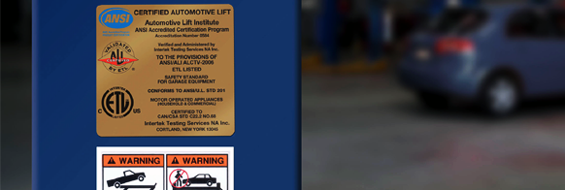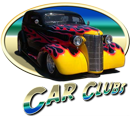Safety Features of Car Lifts
Shop owners are responsible for the safety of those around them, especially when a car lift is in use. Even if you're familiar with garage safety, it's still important to be knowledgeable about car lift safety features. Manufacturers are always updating the safety features of their lifts to keep up with the ever-evolving needs of their customers. The following is a list of features that reputable ALI/ETL certification partners have developed with your safety in mind.
Two-Post Car Lift Automatic Arm RestraintsCar lift designs can vary, meaning some safety features will be unique to specific types of car lifts. In the case of two-post car lifts, such as those manufactured by BendPak and Dannmar, one of the most important safety features is the employment of a swinging arm. This allows the lift's operator to change the arm configuration if necessary to suit a wide range of vehicles. These swing arm lifts employ restraint devices to prevent arms from shifting or dislodging after a vehicle has already been mounted and raised, which reduces or even stops downward travel in a free-fall situation due to hydraulic system failure.
Car Lifts Designed with Safety in MindWithout supervision, pinch points can result in damaged property and even injury. Because of this, reputable manufacturers make sure to employ engineers to identify potential pinch points for hoses and limbs and then remove them from the design of an auto lift before they can cause any issues.
Automatic Safety Features on Car LiftsAutomatic safety locks are load-holding devices that, as the name suggests, automatically engage and lock the lift structure as the car lift raises. This prevents sudden free fall in the case of a suspension component failure. After the lift is raised to the required working height, operators are usually instructed to lower the lift until it is resting safely on the locks. This minimizes wear on the suspension components. Once the locks are engaged, the car lift must be raised slightly before the safety locks release. Load-holding devices should always require an independent and positive action for release, and they should always engage and reset automatically each time the lift is raised.
Safety Devices for Slack Cables / Slack Chain DevicesAll professional-grade car lifts employing cable or chain suspension methods should always incorporate a slack cable or chain device. These act as an automatic brake for the structure in case a suspension component breaks or suddenly goes slack.
Specialized Lifting PadsDifferent types of vehicles should be equipped with specialized lifting pads. The dealer or manufacturer should have various options and accessories for you to customize your lift to your specific needs.
Proper Use and Safety InstructionsAlways ensure your car lift is supplied with detailed operation, inspection, service, and maintenance instructions. These instructions should include the specifications of the lift, lift rated load capacity, significant lift and bay dimensions, power requirements (compressed air and/or electrical), and foundation and floor structural requirements.Car lift installation instructions should be clear with graphics illustrating full step-by-step assembly as well as the following features:
Warning Labels on Car LiftsEach auto lift should always include warning labels and instructions for safely raising and lowering the lift. The warning labels should be located at the point of hazard and easily visible to any operator when they raise or lower the car lift's load.
ALI/ETL CertificationThe Automotive Lift Institute's ETL Certification is an official, uniform way for business owners and private users to determine the safety of a car lift. Car lift companies focused on their lifts' safety will regularly undergo intense third-party testing that nationally recognized testing laboratories conduct. These testing companies will check metallurgy, tensile strength, mechanical engineering, manufacturing quality, electrical compliance, and much more. Car lifts will not receive an ALI/ETL certification if they do not meet the required standards
Safe Systems and ProceduresWhile less obvious and immediate than some of the items listed above, no matter which car lift you purchase, you should always ensure that the manufacturer has prepared and documented quality controls properly. A proper quality assurance system encompasses policies and procedures implemented and managed by quality control personnel to guarantee your lift was made safe for use and how to ensure it stays that way. These policies should address any change or version updates to hardware or software, where appropriate.Most importantly, they should track and document the manufacturing process for as critical a piece of engineering as a car lift. This includes any raw material or purchased parts, as well as end-item conformance testing. Complete safe procedures will even document and report on the tools and methods used to measure conformance and performance. Though other standards may apply, these typically require a national standard such as the National Institute of Standards and Technology (NIST). This means that all gauges, measuring devices, tools, and instruments that affect the final product's quality must meet their own quality and accuracy standards.
You may have questions or concerns when it comes to your car lift safety features. Taking the time to ensure that any lift you're buying or operating has all the proper safety equipment and has undergone proper testing isn't just about keeping you and your employees safe, though it certainly does. Proper safety and training are an investment, protecting you from costly damages, repairs, and liabilities for injuries. If you have any further questions about the safety features of any of our car lifts, please contact us and we'll be happy to help. |
Homepage


Installation & Delivery, Service, Parts, Will Call
Locations Across The Nation
TO SERVE
THE ENTIRE
COUNTRY








 Owned & Operated in the U.S. since 1987
Owned & Operated in the U.S. since 1987




